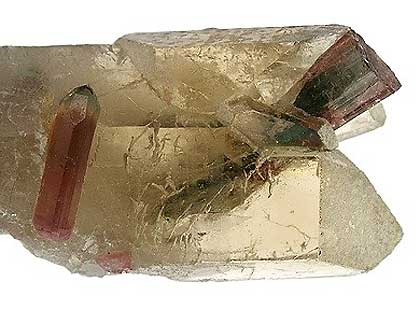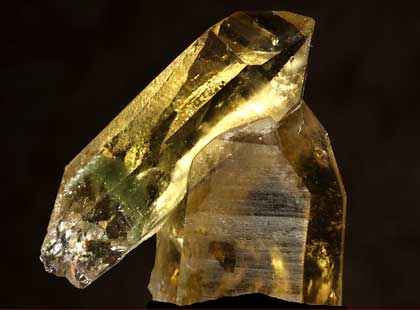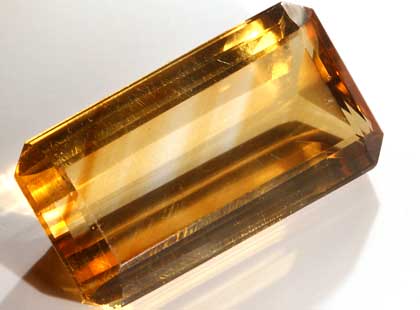Birthstones by the Month
One of the November Birthstones is Citrine
Citrine Mineral Form
With a composition of silicon dioxide, citrine is a quartz mineral quite similar to amethyst except in color. The hexagonal crystal formations result in a transparent to translucent clarity with a vitreous luster. Citrine is most commonly found in igneous formations as heat of the trace iron elements is what produces the yellowish coloring.
Citrine Facts
Referred to as the “sun stone,” Citrine has also been referred to as gold topaz and was named for the citron fruit that has a yellowish flesh similar to lemons. While found throughout the world, Citrine’s largest or most noted deposits have been found in Brazil as well as Argentina, Madagascar, Russia, France, Spain, Hungary and Scotland. Citrine has been traditionally used not only for the November birthstone, but also as the gem for the 13th wedding anniversary. A unique trait of Citrine and Amethyst is they are able to form in the same crystal, resulting in what gemologists refer to as ametrine.

Citrine Quartz Crystal
A very fine specimen of a glassy citrine quartz crystal with diverse inclusions, mostly siderite, from the Adams Hiddenite and Emerald Mine at Hiddenite, North Carolina. [3]
The characteristics of Citrine
Especially popular during the 1940s, Citrine’s bright and sunny color continues to be a favorite as retro-inspired jewelry and color schemes are on the fashion rise. Citrine is often set with other gemstones including ruby, amethyst, peridot and more. Citrine was also valued centuries ago by the Egyptians, Ancient Greeks and then later in the Victorian era. In metaphysical beliefs, Citrine is thought to bring positive thoughts to the wearer. It is said to promote relaxation and dissipate negative energies.
Cut and Clarity for the November birthstone
The clarity of Citrine has the possibility to be flawless, making this a popular stone for jewelry. Citrine is cut into all types of traditional and non-traditional shapes. Most common shapes include elongated ovals and rectangular with step cuts. Not only cut, Citrine has also been carved throughout history.
The value of Citrine
Typically, the deeper the color of the stone, the more valuable the Citrine is. Light yellow colors of Citrine that occur rarely in nature are similarly valuable though when the color is achieved without treatment. Citrine tends to be a more affordable gemstone and is therefore popular for not only setting in pendants and rings, but also as beads in jewelry. While inclusions are not common in Citrine, if they are present they drastically reduce the value of the gem. Carat weights vary greatly.

Citrine Quartz gem
A very large nearly clean gem cut from rough citrine. From a small claim in Riverside County.[4]
Is Citrine ever treated?
Most Citrine is not natural and is actually a result of heat treating amethyst or smoky quartz gemstones. Heat-treated Citrine tends to be darker with a red tint. Other treatment options include irradiation resulting in lighter yellowish tones sometimes called “lemon quartz.” Both of these treatments can happen both naturally and synthetically. Other more rare treatments include dye or fracture-filling to improve surface quality.

Citrine with Tourmaline
This quartz has a bi-colored tourmaline nestled in its terminations. The color is a slight citrine hue, though not intense. The tourmaline is an attractive bicolor, crudely terminated. [5]
More about Citrine the November birthstone
With a Mohs hardness of 7, Citrine lends itself well to jewelry applications. However, due to its crystalline planes of symmetry, Citrine has the ability to ripple fracture or crack if struck with enough force or if there is an abrupt temperature change. For this reason it is unwise to use steam on Citrine. It is also best to not clean Citrine using acids, detergents or other harsh chemicals. Ultrasonic cleaners are safe unless the Citrine is dyed or fracture filled. Simply clean Citrine with warm, soapy water and ensure the stone is completely dry before storing or wearing.
The American Gem Society's November Birthstone page has more information to help you buy from knowledgeable and skilled jewelers and to help you make the most informed buying decision.
Image Attribution
- By Parent Géry (Own work) [Public domain] via Wikimedia Commons
- By Didier Descouens (Own work) [GFDL or CC BY-SA 3.0], via Wikimedia Commons
- Rob Lavinsky, iRocks.com – CC-BY-SA-3.0 [CC BY-SA 3.0], via Wikimedia Commons
- Rob Lavinsky, iRocks.com – CC-BY-SA-3.0 [CC BY-SA 3.0], via Wikimedia Commons
- Rob Lavinsky, iRocks.com – CC-BY-SA-3.0 [CC BY-SA 3.0], via Wikimedia Commons

